Kashmir, India, has a rich history of hand embroidery, having produced master craftspeople who have honed the craft for generations. The region's culture, deeply ingrained in this trade; Kashmiri hand embroidery is especially well-known throughout the world for its beautiful beauty and meticulous attention to detail. The methods, handed down through the decades, entail painstaking handiwork turns fabrics—especially Pashmina into beautiful artwork. Luxurious fabrics, created when exquisite workmanship, vivid colors, and complex patterns come together to create pieces speak to the artisan's commitment.
The Kashmiri handicraft of hand stitching uses Cashmere. Made from the velvety undercoat of Changra goats found in the Himalayan region. Known for its extraordinary warmth and softness, this plush wool takes on a whole new charm when paired with elaborate hand-embroidered patterns. Kashmiri artisans use a range of stitching techniques, such as Aari, Sozni, and Tilla, to adorn Pashmina shawls. All captivating designs that range from intricate paisleys to delicate florals. Every item showcases the artist's talent as well as the cultural distinctiveness and refined aesthetics of Kashmiri hand embroidery.
The combination of hand embroidery, Kashmir, and Pashmina represents a tasteful fusion of tradition and artistry. Hand stitching is a labor of love for craftspeople who meticulously stitch each thread to create exquisite motifs. Thus, perfectly depict Kashmir's rich cultural heritage and natural beauty. These exquisitely stitched Pashmina items are more than just accessories; they are enduring representations of the artist's commitment, the region's natural beauty, and the craft's timeless appeal.
What is the Craft of Pashmina?
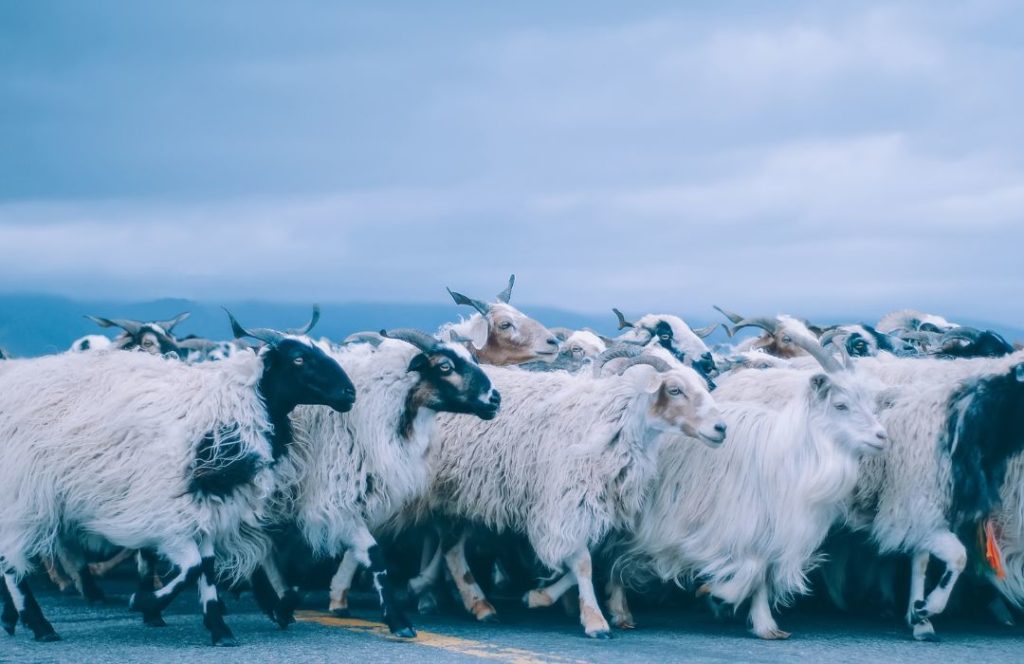
The elaborate and time-honored methods used to create Pashmina textiles—especially the well-known Pashmina shawls—are together referred to as the Pashmina craft. The undercoat of Changthangi goats is mostly found in the Himalayan regions of India. The source of this delicate type of wool is called Cashmere wool. Several crucial steps in the pashmina technique require knowledgeable craftspeople to turn raw pashmina wool into opulent, in-demand clothing.
When the goats naturally lose their winter undercoats during the molting season. The procedure starts with the meticulous gathering of the Cashmere fibers. After being gathered, the wool is carefully cleaned and processed to ensure fibers are all pure and delicate. To preserve the delicate texture of the fibers, the cleaned Pashmina wool was next spun into fine threads, usually by hand.
An essential component of the pashmina technique is hand weaving. The foundation fabric for Pashmina shawls is woven by expert craftspeople using ancient looms to create complex patterns. The quality and workmanship define genuine Pashmina items ensured by the painstaking attention to detail made possible by the hand-weaving method.
In addition to producing opulent fabrics valued for their warmth, softness, and beauty. Pashmina craft, a cultural legacy passed down through the generations of artisans. Every handcrafted item is a testament to the long-standing people who work to preserve Pashmina art.
Procuring the Ladakhi Cashmere?
The Changthang region, a high-altitude plateau in the eastern portion of Ladakh in the northern Indian state. The Changthang region and the Changthangi goats are notable for the following reasons:
Goats from Changthangi:
Breed Specifics: The Changthangi goat, commonly referred to as the Changra goat, ideally suited to the severe climate. They have a distinctive and priceless undercoat of hair called cashmere or pashmina, widely sought after due to its warmth and tenderness.
Production of Pashmina: The main purpose of raising these goats is to produce pashmina wool. The silky undercoat all goats acquire over the winter thus combed to extract the Pashmina fiber.
Adaptation to High Altitude: Changthangi goats are remarkably resilient to the severe weather and reduced oxygen concentrations seen in high-altitude areas. They are resilient to low temperatures, and the heavy fleece they have protects them from inclement weather.
Herding: Traditionally, the pastoral communities in the Changthang region have moved their herds of Changthangi goats to various grazing locations. The local inhabitants and the goats depend on this way of life for survival.
The Pashmina goat, also known as the Changthangi, source of Ladakhi Cashmere, prized for its opulent and superior qualities. Ladakh is a region in India. There are various steps in the procurement process:
- Shearing: During the spring, when their winter coats are at their thickest, Changthangi goats usually shorn once a year. It's the fine undercoat, called Cashmere or Pashmina, prized for its warmth and tenderness.
- Gathering: The gathered fibers further cleansed in Kashmir to eliminate contaminants such as oil, grime, and rough hairs. In order to preserve the cashmere's quality and purity, this cleaning procedure is essential.
Pashmina Craft in Kashmir
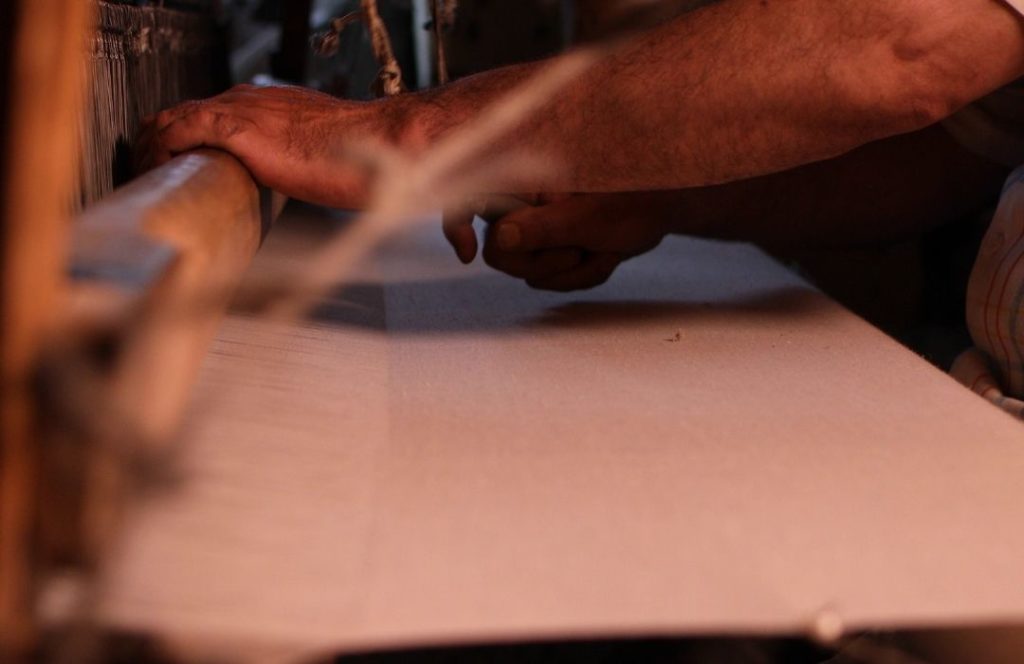
The centuries-old Pashmina craft flourished in places like Kashmir, where the delicate fibers from the Changthangi goat's underbelly fashioned into exquisite textiles. The yearly shearing of the goats' soft, insulating fleece in the springtime kicks off the procedure. Once the wool has been gathered, carefully cleaned to get rid of any impurities. Then, expert craftspeople hand-spin the fibers into exquisite yarn. Pashmina fabric, woven by hand by skilled artisans using antique looms to produce beautiful wraps, scarves, and shawls. A hallmark of the craftsmanship is its painstaking attention to detail. Thus, produces goods not only extraordinarily warm and soft but also embellished with elaborate designs.
Originating in the pure valleys of Kashmir, the Pashmina craft is a testament to a long-standing heritage rich in artistry. A key component of this technique the use of the incredibly fine wool from Changthangi goats. Thus, prized for their resilience to the severe winters in the Himalayas. The goats, first gently sheared, and their soft undercoat all collected. The hand-spinning method, used by knowledgeable craftspeople who frequently operate within their communities, is what sets Pashmina apart. It produces exquisite yarns that perfectly capture the opulent warmth and texture for which Pashmina all known.
Cultural Legacy of Pashmina Craft
The skill with which the Pashmina, crafted is evidence of Kashmir's rich cultural legacy. Craftspeople use age-old methods passed down through the centuries to weave complex patterns and designs into the fabric. The finished scarves and shawls are wearable pieces of art that showcase the artisan's commitment to excellence. Each piece in the craft tells a story through its patterns and motifs, frequently influenced by the folklore of the Kashmiri terrain. The craft also has a strong cultural resonance. By conserving a legacy that has changed over centuries, pashmina craft acts as a link between the past and the present.
Three Styles in Pashmina Craft
There are mainly three styles in Pashmina Craft including Cashmere Wraps, Cashmere Scarves and Pashmina Shawls. In these styles, there are several designs in each. Mainly, Cashmere Wraps and Pashmina Shawls have Hand Embroidered Pashmina design.
Hand Embroidery in Pashmina Craft
A distinguishing characteristic of the Pashmina industry is hand stitching. Thus, gives the already opulent materials an amazing depth of artistry and detail. Expert stitchers, many with years of experience, painstakingly add elaborate embroidery to Pashmina shawls and scarves. Using thin needles, this delicate and time-consuming procedure creates intricate designs frequently influenced by historical, folkloric, or natural themes. Hand stitching transforms Pashmina products into wearable works of art, adding a personal touch and showcasing the artist's imagination and commitment.
Hand embroidery, a centuries-old Pashmina craft tradition passed down through Kashmiri communities' generations. Craftspeople, frequently operating in intimate workshops or from their homes, painstakingly stitch elaborate designs onto the luxurious Pashmina cloth. Thus, exhibiting their proficiency in needlework skills. Embroidery produces pieces are incredibly beautiful and well-made. Thus, take a great deal of time, precision, and design knowledge. Hand-embroidered Pashmina pieces, a timeless masterpiece treasured by lovers of fine textiles. They not only highlight the wool's extraordinary quality but also the artistic ability and cultural legacy of the artists who bring them to life.
Types of Hand Embroideries in Pashmina Craft
Every style of hand embroidery used in Pashmina crafts has unique aesthetic qualities that showcase Kashmir's rich cultural diversity and expertly crafted handiwork. These methods add to the Pashmina textiles' enduring beauty and cultural diversity, making them valuable items valued for their skill and workmanship. There are mainly 4 types of Hand Embroideries in Pashmina Craft.
Sozni Hand-Embroidery
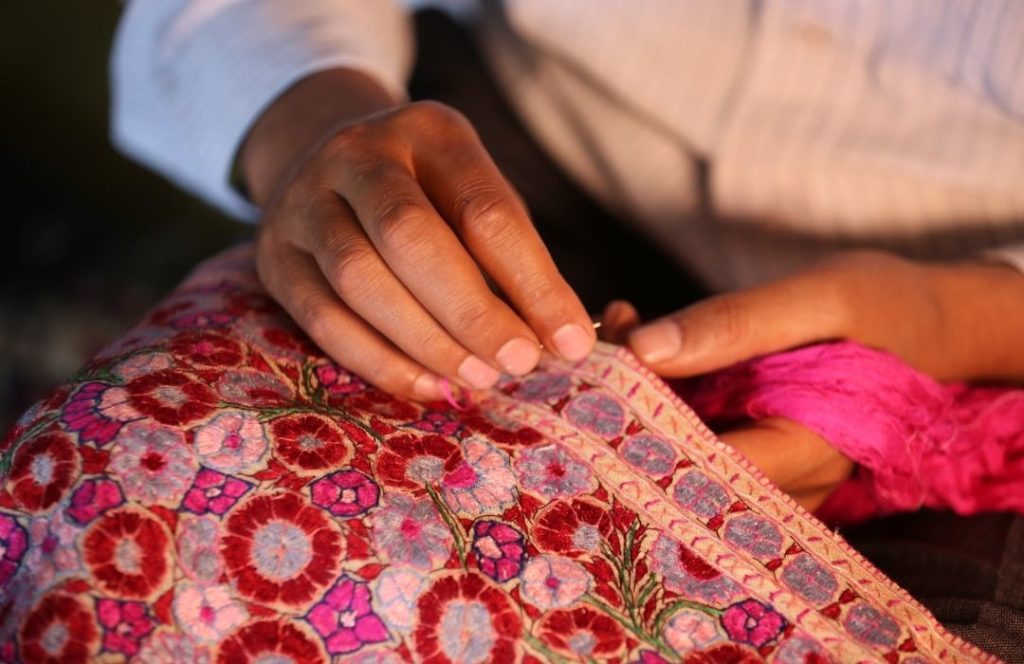
The exquisite creativity and cultural significance of Sozni embroidery, a traditional hand embroidered style from Kashmir's scenic valleys. Expert stitchers painstakingly use a single silk or cotton thread to create intricate designs on Pashmina fabric. The intricate designs frequently incorporate motifs like chinar leaves, paisleys, and flowers, all of derived from Kashmir's rich cultural tapestry. Every thread in Sozni embroidery tells a story and upholds the traditional aesthetics passed down through the years, reflecting the rich creative legacy of the area.
Sozni embroidery, distinguished by its exquisite craftsmanship, made up of tiny stitches that give Pashmina shawls and scarves a refined appearance. Because this hand embroidery is labor-intensive, every item is a testament to the artist's ability and commitment. Textiles made from Sozni embroidery on Pashmina, known for their opulent appeal, providing a blend of warmth, softness, and artistic beauty. Connoisseurs of excellent craftsmanship greatly prize Pashmina products with Sozni embroidery because it adds a touch of elegance to the overall design. Whether used to highlight particular borders or create elaborate all-over patterns.
Sozni embroidery is essential to maintaining Kashmiri craftsmanship and boosting the local economy in the area. Many artists and their families, supported by this art form, which frequently passes down skills through community apprenticeships. As Embroidered Pashmina products become more well-known worldwide, they are drawing in both traditional and modern markets and have grown to be a vital component of the local economy. In addition to guaranteeing the survival of a treasured custom, the painstaking handiwork required in Sozni embroidery establishes it as a representation of Kashmiri identity and superior artistic quality in the field of textile craftsmanship.
Role of Artisans in Sozni Embroidery
In Kashmir's rich cultural legacy, Sozni embroidery is a traditional handicraft in which artisans are integral and necessary to the exquisite technique. A great degree of dexterity, artistic sensibility, and expertise needed to create Sozni-embroidered Pashmina textiles, and artists emphasize these attributes.
The technique of Sozni embroidery requires exacting proficiency in exquisite workmanship. Artists make elaborate patterns on Pashmina cloth using a single strand of silk or cotton thread, a skill they have frequently honed over years of training and practice. Each motif adds to the overall beauty and richness of the finished piece, thus the delicate stitches need for a steady hand and close attention to detail. Achieving a smooth integration of designs, learning a variety of stitching techniques, and maintaining consistency are all necessary for the competent execution of Sozni embroidery.
Kashmiri artisans are essential to the Sozni embroidery tradition's survival. Many craftspeople carry on the methods and designs that characterize this distinctive kind of hand embroidery by handing down their knowledge from earlier generations. By upholding these customs, craftspeople support Kashmir's cultural survival and guarantee that Sozni embroidery will always be a vibrant representation of the area's rich artistic history. For this craft to continue through the years, master artisans must pass on their knowledge to apprentices within their communities.
Craftspeople are essentially the ones who preserve the Sozni embroidered legacy by bringing their imagination, knowledge, and commitment to every painstakingly made item. Their contribution to the world of luxury workmanship goes beyond simple sewing; they are the guardians of a cultural heritage and the main factor in the Sozni-embroidered Pashmina textiles' ongoing vibrancy and relevance.
Sozni Pashmina Shawls
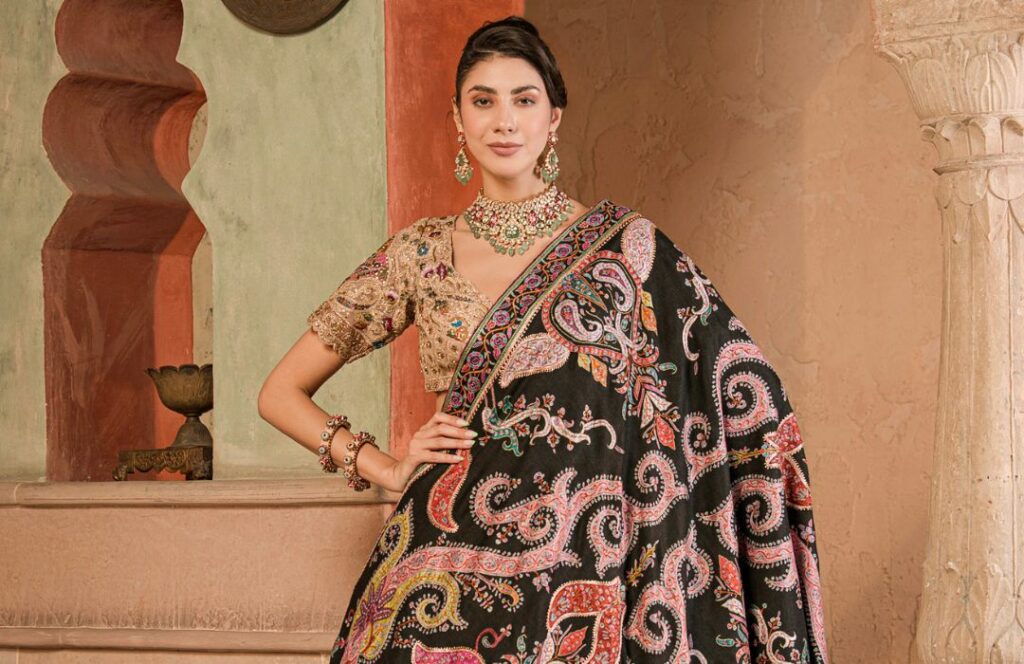
The unmatched softness of Pashmina wool and the exquisite beauty of Sozni hand embroidery, combined to create Sozni Pashmina shawls, all masterpieces of exquisite craftsmanship. Using a single strand of silk or cotton thread, artisans painstakingly hand-embroider elaborate patterns onto the exquisite Cashmere fabric. Traditionally Kashmiri designs, such chinar leaves, paisleys, and florals, frequently expertly woven into the fabric of these shawls. The end product is a wearable work of art that exemplifies the artist's talent, meticulous attention to detail, and classic Sozni stitching style.
Sozni Pashmina shawls, prized for their elegant design and adaptability. The exquisite embroidery provides an additional level of refinement, turning the shawls into eye-catching accessories fit for both dressy events and casual attire. The elaborate designs add to the shawls' airy and light appearance in addition to improving their aesthetic appeal. Because of their adaptability, Sozni Pashmina shawls worn with equal grace for both daytime and evening wear all offer warmth and style.
Sozni Pashmina shawls are extremely symbolic and rich in cultural history, even beyond their attractive appearance. Traditional Kashmiri patterns used into Sozni embroidery as a tribute to the region's diverse cultural heritage. These shawls frequently become treasured heirlooms handed down through the generations, protecting Kashmir's artistic tradition and cultural identity. Making Sozni Pashmina shawls is more than just a craft; it's a representation of the artistic heritage that lives on in the hands of talented craftspeople, bridging the past and present.
Sozni Cashmere Wraps
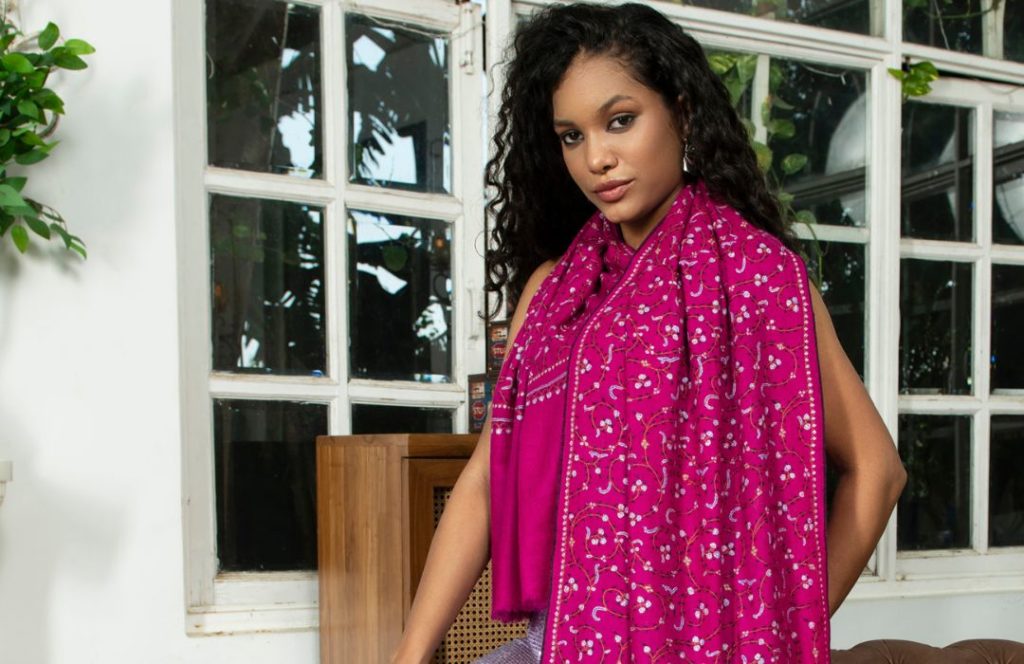
Wraps made with Sozni Cashmere represent the height of artisanal sophistication, combining the exquisite beauty of Sozni hand embroidered with the unparalleled softness of Cashmere. These wraps, made by talented craftspeople in Kashmir, highlight the delicate artistry of Sozni embroidery, which uses a single strand of cotton or silk thread to create intricate patterns on luxurious Cashmere fabric. The end product is an opulent piece of jewelry that serves as a wearable tribute to the region's handiwork and cultural legacy in addition to providing warmth.
The delicate details painstakingly woven into the fabric are the distinguishing feature of Sozni Cashmere wraps. The wraps given depth and richness by the artisans' frequent incorporation of geometric patterns, traditional Kashmiri motifs, and nature-inspired designs. Cashmere's light weight and airiness, along with the dexterity of Sozni stitching, produce wraps that drape beautifully and are quite versatile. Wraps made of Sozni Cashmere are perfect for both formal and informal settings, adding a timeless appeal to any combination.
In conclusion, Sozni Cashmere wraps combine the finest Cashmere with the dexterity of hand embroidery from Sozni to create manifestations of art and culture. Every opulent Cashmere wrap perpetuates the legacy of Sozni embroidery by encapsulating the heritage of Kashmir and offering a physical connection to the talented artisans who painstakingly produce each piece in addition to providing warmth.
Tilla Dozi Hand Embroidery
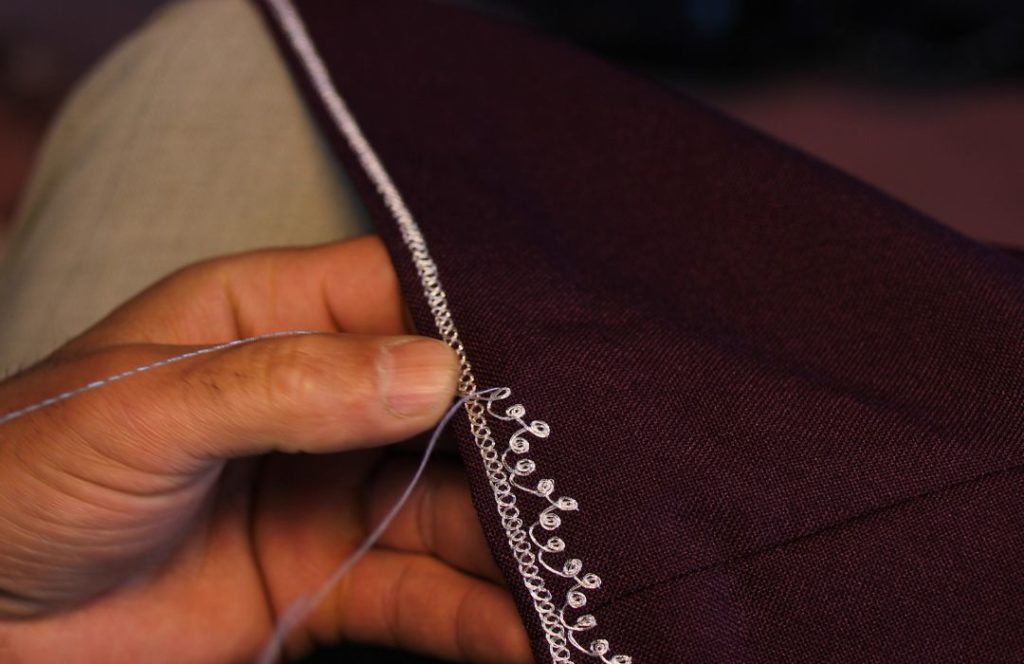
The distinctive feature of tilla or Zari embroidery is the embellishment of materials with metallic threads, typically composed of gold or silver. Using this method, tiny metallic wires applied to the fabric's surface to create complex patterns and designs. The metallic threads give the cloth an affluent and luxuriant appearance all utilized to cover bigger regions or outline designs.
Tilla needlework, well known for its exquisite artistic quality, which gives textiles a sense of grandeur. Thus, frequently used to adorn ceremonial linens, bridal gowns, and traditional apparel. Tilla-embellished objects stand out for their regal and festive appearance due to the shimmering impact of the metallic threads, which also improves the overall visual appeal. The addition of Tilla or Zari embroidery to Pashmina workmanship elevates the already exquisite Pashmina wool to a new level of grandeur and sophistication. Metallic threads thus expertly embroidered by artisans onto Pashmina wraps or shawls to create elaborate motifs, borders, or overall designs. This product is distinctive and visually striking since it combines Tilla needlework with Pashmina wool.
Combining the softness of Pashmina wool with the glittering elegance of metallic threads, Tilla embroidery and Pashmina craft symbolize an artistic synergy. This blend appeals to people who value the exquisite artistry of traditional hand embroidery as well as the opulent allure of Pashmina fabrics. When it comes to Pashmina crafts, Tilla Dozi is likely to create items that are not just cozy and warm but also eye-catching and appropriate for special events. Since metallic embellishments frequently connected to formal gatherings, weddings, and celebrations, the usage of Tilla embroidery in Pashmina crafts may have cultural and festive importance. Tilla-embroidered Pashmina garments can become treasured accessories worn at important celebrations, combining craft, heritage, and festive style.
Tilla Dozi Pashmina Shawls
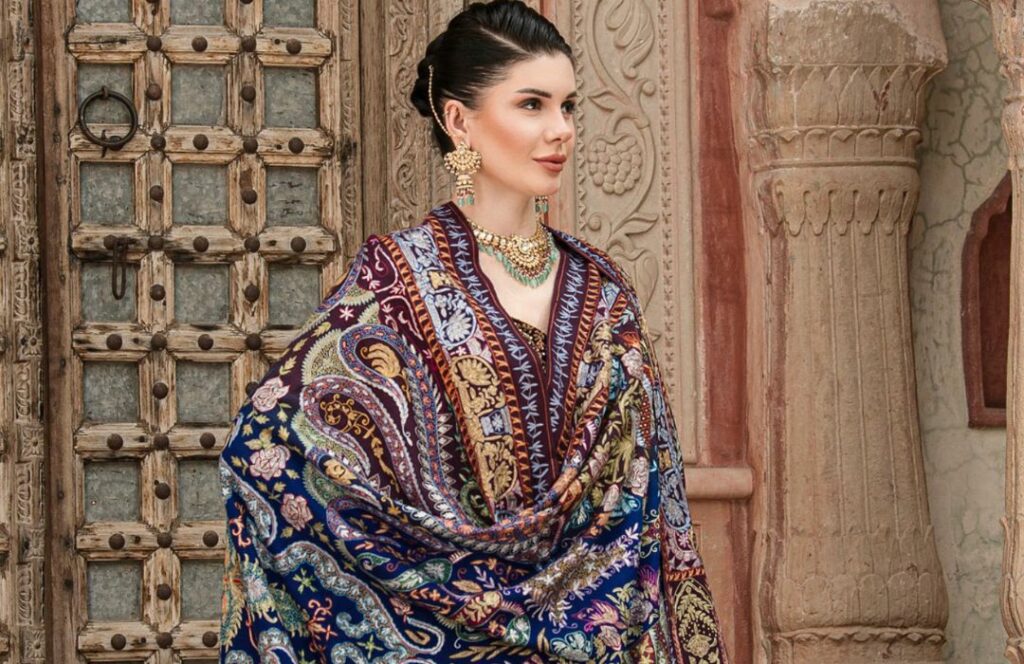
Tilla Dozi Pashmina shawls are the epitome of luxury and custom combined. The exquisite softness of Pashmina wool and the elaborate elegance of Tilla or Zari embroidery combine to create stunning shawls. The Pashmina fabric elaborately woven with metallic threads, usually silver or gold in hue, to form complex motifs, borders, and patterns. The end product is a gorgeous wearable artwork that showcases the artistry of Tilla and Pashmina embroidery, in addition to offering warmth and comfort.
The creation of Tilla Dozi Pashmina shawls necessitates a high degree of artisanal competence. Expert artisans painstakingly stitch each piece by hand, focusing on every little detail. The delicate gold or silver threads give the shawls a royal feel.
Because Tilla Dozi Pashmina shawls frequently exude cultural grandeur, they are perfect for festivities and special occasions. The shawls' added cultural significance comes from the metallic threads used in the needlework, inspired by conventional patterns and motifs. These items evolve from simple ornaments into proudly worn emblems of cultural heritage during holidays, marriages, and other significant ceremonies. In the context of Pashmina workmanship as a whole, Tilla Dozi Pashmina shawls so aid in the preservation and appreciation of traditional aesthetics.
To summarise, Tilla Dozi Pashmina shawls are an elegant combination of the natural beauty of Pashmina and the detailed stitching of Tilla embroidery. These shawls represent the creative heritage of accomplished craftspeople and are not merely opulent and cozy accessories.
Tilla Dozi Cashmere Wraps
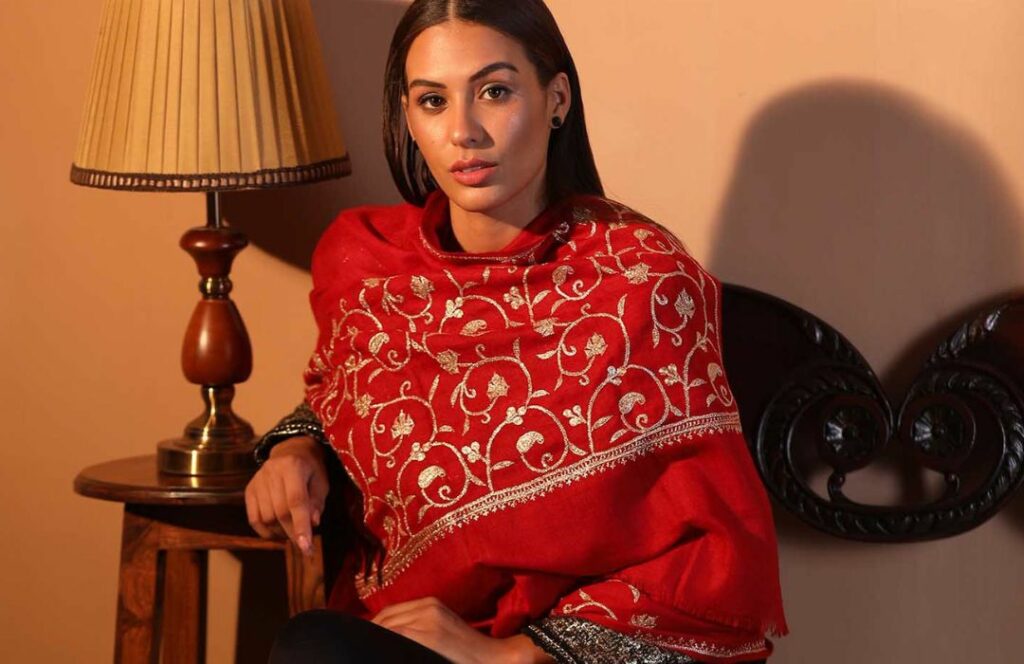
Tilla Dozi Cashmere wraps combine the unmatched softness of Cashmere wool with the elaborate beauty of Zari or Tilla embroidery to create the ultimate sumptuous blend of comfort and richness. Expert weavers carefully adorn the Cashmere fabric with metallic threads, frequently in gold or silver, to create elaborate borders, patterns, or motifs. As a result, the wrap is a remarkable piece of warmth and comfort as well as an eye-catching piece. Thus, showcases the skill of Tilla embroidery and Cashmere weaving.
Tilla Dozi Cashmere wraps crafted with great care and attention to detail, requiring a high level of artisanal expertise. Each wrap, painstakingly made by artisans skilled in Tilla embroidery and Cashmere weaving. The exquisite metallic threads perfectly complement the delicate quality of Cashmere wool. Thus, highlighting the artistry and attention to detail of the artists who create these wraps.
Cashmere wraps made by Tilla Dozi, known for their cultural significance. Thus, probably because the Tilla needlework incorporates traditional themes and styles. These wraps go beyond their use as fashion accessories to become emblems of classic style and national pride. Tilla Dozi Cashmere wraps, whether worn for weddings, holidays, or other special occasions, bring with them a legacy of craftsmanship. Thus, surpassing fashion trends and links the wearer to the cultural heritage of places where such elaborate embroidery techniques have been practiced for centuries.
Papier Mache Hand Embroidery
The harmonious amalgamation of Kashmir's abundant cultural heritage, papier mache hand embroidery on Pashmina. Thus, it pays homage to the meeting point of two distinct yet exquisite artistic traditions. To further accentuate the grandeur of these textiles, the intricate papier mache elaboration, a traditional Kashmiri technique. Thus, expertly mixed with the delicate weave of Pashmina. Applying the tedious method of Papier Mache on Pashmina shawls requires skill and accuracy. The result is a breathtaking visual tapestry of skillfully rendered themes and designs that softly adorn the Pashmina's surface. The elaborate patterns, florals, and landscapes of Kashmir are often reflected in these designs and motifs.
Richness of Papier Mache
In conclusion, Pashmina shawls with Papier Mache embroidery are proof of the endless possibilities for artistic expression. In addition to demonstrating how ancient crafts may be adapted to modern aesthetics, these shawls also represent a distinctive fusion of materials. Also techniques, and cultural influences, thus creating wearable works of art that go beyond traditional limitations.
The artisans responsible for this exquisite embroidery undergo a rigorous training program to perfect the technique of hand-embroidered papier-mâché on Cashmere. Each piece is a labor of love that displays the artists' technical proficiency and dedication to preserving and advancing traditional Kashmiri arts. Beyond just being aesthetically beautiful, the combination of pashmina and papier mache creates a tactile. Thus, visually appealing texture and depth that give people who appreciate the beauty of handcrafted textiles a unique and sumptuous aesthetic.
Papier Mache Pashmina Shawls
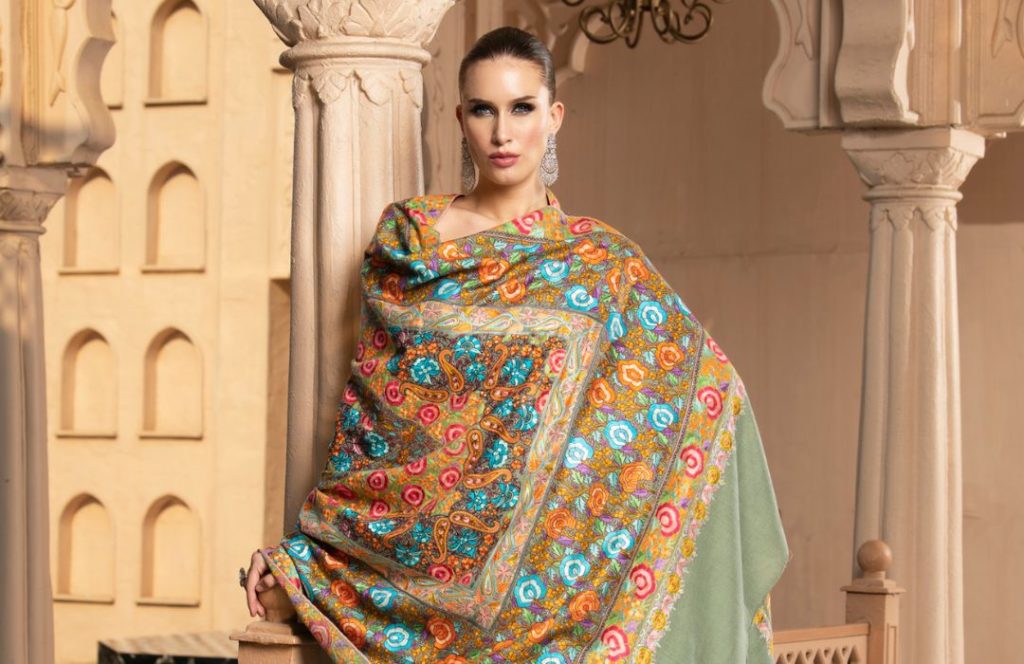
The combination of embroidery and Papier Mache on Pashmina shawls is an amazing example of inventive craftsmanship. Thus, combines several artistic traditions. Papier Mache elements, such as complex designs, patterns, or three-dimensional embellishments. Thus, expertly created by artisans and then gently embroidered into the opulently soft Cashmere fabric. This special fusion produces shawls that are visually arresting as well as a harmonic fusion of several artistic mediums.
The use of Papier Mache components gives Pashmina shawls a three-dimensional appearance that adds texture and depth. The Papier Mache components, can include raised patterns, sculpted florals, or elaborate designs. Thus, add to the overall elegance of the shawls. These shawls become wearable works of art when the fine stitching is paired with the softness of pashmina. Thus, perfectly balances the detailed Paper Mache details.
The shawls become both fashion items and cultural symbols if the Papier Mache pieces, inspired by regional or cultural motifs. Shawls that convey a tale of creative communication between many artistic traditions and cultural variety. Pashmina shawls with paper mache embroidery are an opulent display of artistry and skill. These shawls, which combine sculptural intricacy with tactile softness, are likely to appeal to anyone looking for distinctive clothing. Rich materials and cutting-edge methods come together to make every item unique. Thus, showcasing the artist's talent and the elegance of blending cultures.
Papier Mache Cashmere Wraps
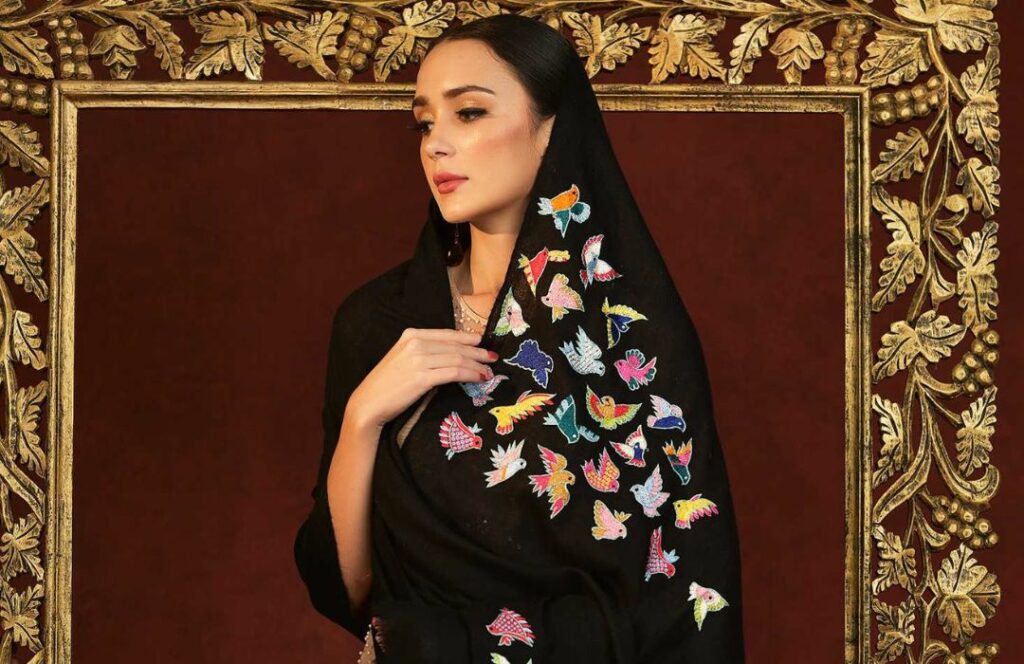
The incorporation of Papier Mache gives Cashmere wraps a three-dimensional element that improves their aesthetic appeal. The Papier Mache components give the wraps a sense of depth and texture. Whether they take the form of raised patterns, sculpted decorations, or elaborate designs. The exquisite stitching guarantees every element exquisitely brought to life. Thus, producing wraps not only plush and opulent but also striking to look at.
The wraps become more than just fashion accessories if the Paper Mache elements, inspired by cultural motifs. Instead, they become carriers of cultural messages. The combination of Paper Mache, renowned for its intricate sculpture, and Cashmere. Thus, famed for its unmatched softness, produces wraps that are both aesthetically pleasing and culturally meaningful. This amalgamation of conventional methods signifies a synthesis of several creative traditions.
Cashmere wraps with paper mache embroidery make a distinctive and sophisticated style statement. The finest Cashmere wool and expertly created Paper Mache components come together to produce wraps distinctive pieces of wearable art. These items are probably going to be appealing to people who value the artistic expression and cultural nuance.
Also read: Which country is Pashmina from?
Conclusion
Cashmere wraps with Paper Mache embroidery are a tasteful combination of luxury and creativity. These wraps offer a unique combination of softness, luxury, and cultural importance that goes beyond the bounds of traditional fashion. Every item turns into a monument to the artistry of the craftspeople and the possibilities for avant-garde expression in the luxury fashion industry.
Also read: 7 Myths surrounding Pashmina